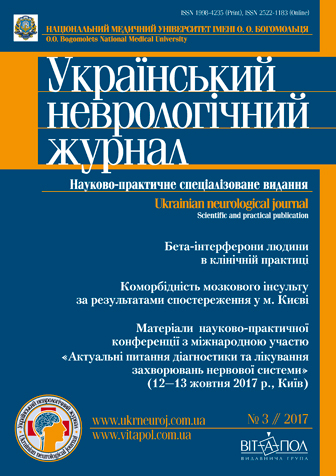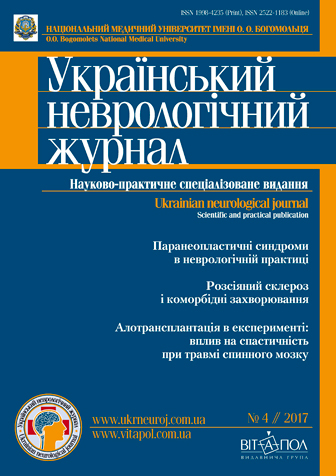- Issues
- About the Journal
- News
- Cooperation
- Contact Info
Issue. Articles
¹3(44) // 2017

1. Reviews
|
Notice: Undefined index: picture in /home/vitapol/ukrneuroj.vitapol.com.ua/en/svizhij_nomer.php on line 74 Notice: Undefined index: pict in /home/vitapol/ukrneuroj.vitapol.com.ua/en/svizhij_nomer.php on line 75 Indications for application of human β-interferon in clinical practiceD. V. Maltsev 1, L. I. Sokolova 1, V. G. Kolerova 21 O. O. Bogomolets National Medical University, Kyiv |
|---|
Keywords: multiple sclerosis, beta-interferon, immunotherapy.
Notice: Undefined variable: lang_long in /home/vitapol/ukrneuroj.vitapol.com.ua/en/svizhij_nomer.php on line 188
2. Original researches
|
Notice: Undefined index: picture in /home/vitapol/ukrneuroj.vitapol.com.ua/en/svizhij_nomer.php on line 74 Notice: Undefined index: pict in /home/vitapol/ukrneuroj.vitapol.com.ua/en/svizhij_nomer.php on line 75 Prediction of functional output in early recovery period of cerebral hemispheric ischemic stroke based on the determining of serum level of neuron specific enolaseS. O. MedvedkovaZaporizhzhia State Medical University |
|---|
Methods and subjects. Ñomplex clinical instrumental-laboratory research was done among 72 patients (mean age of patients is 57.4 ± 1.2 years) in early recovery period of CHIS using National Institute of Health Stroke Scale, Barthel Index, modified Rankin Scale on the 10th, 30th, 90th and 180th day of disease, computed tomography of the brain. The level of neuron specific enolase in blood serum was determined on the 10th day of disease. ROC-analysis was used for the development of criteria for prediction.
Results. It was defined that among the patients with CHIS, whose indexes according to modified Rankin Scale (mRS) on the 180th day of disease were ≥ 3 points differed by higher level of neuron specific enolase (NSE) in comparison with the patients with indexes as for mRS 3 < points (3.54 [2.29; 4.44] mkg/l against 1.56 [0.59; 2.58] mkg/l, p < 0.05); level of NSE > 1.4 mkg/l on the 10th day of CHIS is the predictor of indexes ≥ 3 points following mRS on the 180th day of disease (sensitivity = 90.0 %, specificity = 45.2 %);
Conclusions. Serum level of neuron specific enolase on the 10th day of CHIS is more informative for prediction of the disability level following modified Rankin’s scale on the 180th of disease (AUC = 0.74) than the level of functional independence as for Barthel Index (AUC = 0.64, p < 0.05).
Keywords: hemispheric ischemic stroke, neuron specific enolase, prediction.
Notice: Undefined variable: lang_long in /home/vitapol/ukrneuroj.vitapol.com.ua/en/svizhij_nomer.php on line 188
3. Original researches
|
Notice: Undefined index: picture in /home/vitapol/ukrneuroj.vitapol.com.ua/en/svizhij_nomer.php on line 74 Notice: Undefined index: pict in /home/vitapol/ukrneuroj.vitapol.com.ua/en/svizhij_nomer.php on line 75 Ñomorbidity of cerebral stroke based on pragmatic observation in KyivÌ. Ì. Prokopiv 1, S. V. Rohoza 1, L. Ì. Òrepet 2, L. Î. Vakulenko 2, S. R. Peleshok 4, Yu. D. Karnaukh 4, H. Ì. Litovaltseva 4, M. L. Tsariuk 51 O. O. Bogomolets National Medical University, Kyiv |
|---|
Methods and subjects. The study included an examination of 1.575 patients with acute cerebral stroke (males 42.6 %) aged 26 to 100 years old (mean age 70.5 ± 10.7 years) who were hospitalized from June 1 to December 31, 2016 to neurological departments in the city of Kyiv. Medical comorbidity in stroke patients was assessed using the modified Charlson Comorbidity Index (CCI).
Results. It has been established that in 71.5 % of the examined patients, stroke occurred for the first time in their life. Patients aged 60 years and older dominated (84.1 %). In this cohort of stroke patients comorbid conditions were in 97.7 %,with CCI scores ranging from 0 to 8. Patients with primary stroke had lower rate of comorbidity — 3.5 ± 1.5 points, compared with patients who suffered repeated stroke — 3.8 ± 1.4 points; the difference in the rates was statistically significant (p < 0.01). Patients with ischemic stroke had higher CCI rate compared with patients with hemorrhagic stroke (p = 0.012). Patients with high and low levels of comorbidity had a statistically significant difference in scores on the Glasgow coma scale (p < 0.01), severity of neurologic deficits in the NIHSS scale (p < 0.01), and duration of treatment in a neurological department (p = 0.038). Only 49 % of patients with CCI ≥ 2 achieved a modified Rankin Scale score of 2 or better at discharge compared with 83 % of patients with CCI ≤ 1 (p < 0.01). The risk of a death in the acute period of a stroke was related to the level of comorbidity by the CCI (p < 0.01).
Conclusions. Medical comorbidities as measured by the CCI influence severity of stroke and short-term outcome after stroke. In order to improve the quality of care for patients with cerebral stroke, more attention should be paid to preventive measures against primary damage of the cardiovascular system and educational work among the population.
Keywords: ischemic stroke, haemorrhagic stroke, epidemiology, comorbidity, Charlson Comorbidity Index, risk factors of stroke, outcome.
Notice: Undefined variable: lang_long in /home/vitapol/ukrneuroj.vitapol.com.ua/en/svizhij_nomer.php on line 188
4. Original researches
|
Notice: Undefined index: picture in /home/vitapol/ukrneuroj.vitapol.com.ua/en/svizhij_nomer.php on line 74 Notice: Undefined index: pict in /home/vitapol/ukrneuroj.vitapol.com.ua/en/svizhij_nomer.php on line 75 Prognostic assessment of cognitive and emotional impairments according to demyelization lesions location in patients with multiple sclerosisO. M. Mialovytska, Yu. V. KhyzhniakO. O. Bogomolets National Medical University, Kyiv |
|---|
Methods and subjects. The examination was carried out for 87 patients with cognitive decline, 92 — with symptoms of fatigue, 79 — with depression. MRI examination of the brain on an MR-tomograph with a magnetic field induction of 1.5 T was performed. Cognitive impairment assessment was conducted using Montreal cognitive assessment scale (MoCA). For detecting fatigue, Krupp’s Fatigue Severity Scale (FSS) was used. Depression was detected using Beck’s Depression Inventory. Results procession was performed with methods of descriptive statistics; to assess statistical significance of indexes we used parametric (Student t-criterion) and nonparametric (Vilcocson T-criterion) criteria. Prognostic value of indexes was determined with diagnostic odds ratio.
Results. Presence of atrophy of the corpus callosum statistically significantly increased risk of cognitive impairment in MS patients (OR = 26 (3.40 — 198.9), p = 0.0001). Prognostic assessment of fatigue symptoms reliably depended on the presence of the atrophy of corpus callosum (OR = 2.82 (0.98 — 8.11), p = 0.047), lesions in the parietal lobes (OR = 2.46 (1.02 — 5.9), p = 0.041) and confluent lesions (OR = 2.58 (0.96 — 6.97), p = 0.05). Statistically significant prognostic assessment of depression development in MS patients was obtained by the following indices: the corpus callosum atrophy (OR = 2.81 (1.15 — 6.86), p = 0.021), lesions in the temporal lobes (OR = 5.22 (2.29 — 11.89), p = 0.001) and confluent lesions (OR = 3.45 (1.42 — 8.41), p = 0.005).
Conclusions. Particular localization of demyelinating lesions in the white matter of the brain may be a prognostic factor for the development of cognitive and emotional disorders in patients with multiple sclerosis.
Keywords: multiple sclerosis, cognitive disorders, fatigue, depression, magnetic resonance imaging.
Notice: Undefined variable: lang_long in /home/vitapol/ukrneuroj.vitapol.com.ua/en/svizhij_nomer.php on line 188
5. Original researches
|
Notice: Undefined index: picture in /home/vitapol/ukrneuroj.vitapol.com.ua/en/svizhij_nomer.php on line 74 Notice: Undefined index: pict in /home/vitapol/ukrneuroj.vitapol.com.ua/en/svizhij_nomer.php on line 75 Influence of complex treatment using transcranial direct current stimulation on the electroencephalographic parameters in children with symptomatic epilepsyK. V. YatsenkoBogomoletz Institute of Physiology of NAS of Ukraine, Kyiv |
|---|
Methods and subjects. 29 patients with various forms of epilepsy were examined and treated (mean age 2 — 12 years). 14 children were included in comparison group who underwent basic treatment, and 15 children were in the main group who underwent basic treatment and tDCS. tDCS was performed according to individual treatment regimens. The dynamics of bioelectric activity of brain was evaluated twice using EEG — before the treatment and 3 months after the therapeutic course.
Results. Analysis of electroencephalograms of children with epilepsy of both groups before treatment showed various epileptic related changes: multiple slow spikes, sharp -waves and epileptic related complexes were recorded. After the termination of the course of tDCS, the children had a marked improvement in the electroencephalographic pattern: a decrease in the severity of epileptic related changes was observed; an increase in the frequency and amplitude of alpha- and beta-rhythms, and a decrease in the amplitude and frequency of delta- and theta-rhythms were recorded.
Conclusions. The obtained data indicate that the transcranial direct current stimulation in the complex treatment of patients with epilepsy promotes an improvement in the electroencephalographic pattern, and may also positive influence the clinical course of the disease.
Keywords: epilepsy, electroencephalography, transcranial direct current stimulation.
Notice: Undefined variable: lang_long in /home/vitapol/ukrneuroj.vitapol.com.ua/en/svizhij_nomer.php on line 188
6. Experimental researches
|
Notice: Undefined index: picture in /home/vitapol/ukrneuroj.vitapol.com.ua/en/svizhij_nomer.php on line 74 Notice: Undefined index: pict in /home/vitapol/ukrneuroj.vitapol.com.ua/en/svizhij_nomer.php on line 75 Comparative analysis of the rat’s paretic limb motor function level after spinal cord injury and restorative neuroengineering interventionsV. I. Tsymbaliuk 1, 2, V. V. Medvediev 2, Yu. Yu. Senchyk 3, N. G. Draguntsova 11 SI «Institute of Neurosurgery named after acad. A. P. Romodanov of NAMS of Ukraine», Kyiv |
|---|
Methods and subjects. As the primary digital data, empirical material obtained in a number of previous studies [V. I. Tsymbaliuk et al., 2016, 2017] was used. Animals: mature (5.5 months, 300 g; 1 month, 50 g) white male rats (inbreed line derived from Wistar), male Wistar male rats. Experimental groups: «LSH» — spinal cord left-side hemisection (LSH) at the Ò11 level (n = 40); «LSHJUV» — LSH in a young animals (1 month, n = 32); «OBTT» — LSH + immediate homotopic OBTT (n = 34); «NG» (NeuroGel) — LSH + macroporous hydrogel immediate homotopic implantation (n = 20); «NG+NSC» — ËSH + macroporous hydrogel with mouse fetal (E17) hippocampal NSC immediate homotopic implantation (n = 20). Monitoring the paretic hindlimb function indicator (FI) was performed with the Âasso — Âeattie — Âresnahan scale (BBB). FI weekly gain (VFI, points per week — p/w), gain acceleration (àFI, points2 per week — p2/w) calculation, as well as statistical analysis was performed within the software package Statistica 10.0.
Results. Peaks of the VFI was observed at the 1st and 2nd weeks («LSH», «LSHJUV», «OBTT»), in the «NG» group — at the 1st, 2nd, 3rd, 6th and 7th week, in the «NG+NSC» group — at the 1st, 2nd, 3rd, 6th, 7th, 8th and 12th week. Peak àFI was observed at the 1st («LSH», «OBTT»), 1st and 5th («LSHJUV»), 1st and 6th («NG+NSC»), 1st, 2nd and 6th («NG») weeks of observation.
Conclusions. Taking into account the obtained data, it can be assumed that the OBTT limits the response of the early secondary alteration, macroporous hydrogel implantation — to more extent stimulates early neuroplastic reactions and remyelinization of fibers of the perifocal zone, NSC transplantation in combination with macroporous hydrogel, in addition to the mentioned two mechanisms, stimulates the plasticity of neuronal networks and the growth of nerve fibers through the lesion area in the intermediate and late period of trauma.
Keywords: spinal cord injury, limb motor function, gain of motor function and gain acceleration, olfactory bulb tissue transplantation, macroporous hydrogel, neural stem cells, dynamic analysis.
Notice: Undefined variable: lang_long in /home/vitapol/ukrneuroj.vitapol.com.ua/en/svizhij_nomer.php on line 188
7. Experimental researches
|
Notice: Undefined index: picture in /home/vitapol/ukrneuroj.vitapol.com.ua/en/svizhij_nomer.php on line 74 Notice: Undefined index: pict in /home/vitapol/ukrneuroj.vitapol.com.ua/en/svizhij_nomer.php on line 75 The efficiency of using green fluorescent protein as a marker for the identification of transplanted neural progenitor cells in mice nervous tissueO. M. Tsupykov 1, 2, V. M. Kyryk 2, K. V. Yatsenko 1, G. M. Butenko 2, G. G. Skibo 1, 21 Bogomoletz Institute of Physiology of NAS of Ukraine, Kyiv |
|---|
Methods and subjects. Neural progenitor cells (NPCs) isolated from the hippocampus of the FVB-Cg-Tg(GFPU)5Nagy/J mice transgenic by the GFP gene were transplanted stereotactically into hippocampus of the experimental animals. 90 days after GFP-positive NPC transplantation, an immunohistochemical analysis of brain sections at the light and electron microscopic levels using antibodies against GFP was performed.
Results. An immunohistochemical study using antibodies against GFP showed that at the 90th day after transplantation in the hippocampus, GFP-positive cells were differentiated into the cells with neuronal and glial morphology. The ultrastructural analysis showed that transplanted GFP-positive cells formed synaptic contacts between donor cells and recipient’s neurons at 90 days after transplantation.
Conclusions. The results of the study indicate that GFP is a reliable non-toxic marker that allows to identify donor cells even in the late (up to 90 days) post-grafting period. Immunohistochemical staining of brain sections using antibodies against GFP allows to visualize donor GFP-positive cells at both light and electron microscopic levels.
Keywords: green fluorescent protein, neural progenitor cells, transplantation.
Notice: Undefined variable: lang_long in /home/vitapol/ukrneuroj.vitapol.com.ua/en/svizhij_nomer.php on line 188
Current Issue Highlights
¹4(45) // 2017

Paraneoplastic syndromes in neurological practice
E. G. Dubenko, L. I. Kovalenko
Analysis of comorbid diseases in patients with multiple sclerosis
Ò. ². Nehrych, Ê. Ì. Hychka
Comparative analysis of the rat’s paretic limb spasticity against the background of spinal cord injury, adult olfactory bulb and fetal cerebellum tissue allotransplantation
V. I. Tsymbaliuk 1, 2, V. V. Medvediev 2, Yu. Yu. Senchyk 3, N. G. Draguntsova 1
Log In
Notice: Undefined variable: err in /home/vitapol/ukrneuroj.vitapol.com.ua/blocks/news.php on line 50

